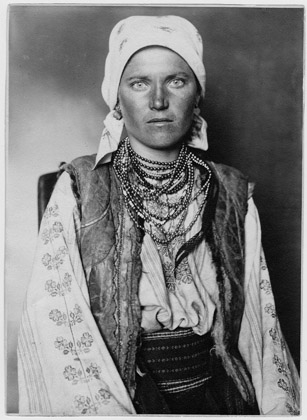This post is also available in:
 Anglais
Anglais
Retratos de Ellis Island. 1905 – 1920
Entre los años 1905-1907, la más grande estación migratoria trataba en promedio, más de 5.000 inmigrantes por día. Augusto Frederick Sherman comenzó a trabajar en el servicio público como empleado en la División de Inmigración de Ellis Island en 1892, año de creación de la "Puerta de Oro". Como confirmado fotógrafo aficionado, la posición de Sherman le permitió tomar una increíble cantidad de retratos de más de 200 familias, grupos e individuos mientras estos permanecían detenidos, ya sea por razones médicas o administrativas. La exposición "Augusto Frederick Sherman: Retratos de Ellis Island, 1905-1920" reúne por primera vez una colección de estas sorprendentes fotografías, con una importancia histórica sin precedentes.
Descrita por los historiadores de la fotografía como "Uno de los archivos fotográficos más importantes de este período de la inmigración masiva" Las fotografías de Sherman ilustran el flujo de inmigrantes llegados a la Ellis Island a comienzos del siglo pasado. Dado que el 20% de los inmigrantes fueron detenidos, algunos de ellos fotografiados por Sherman fueron finalmente expulsados. Sus retratos reflejan la diversidad cultural y étnica de la población conocida como "nuevos inmigrantes", que huían de las sociedades rurales, los desastres naturales, la pobreza, la persecución política y religiosa, para participar al gran sueño americano. Los personajes fotografiados por Sherman son vestidos a menudo con sus trajes nacionales, de ropa sofisticada o folklórica: Pastores rumanos, rusos vegetarianos, anarquistas deportados, artistas de circo, polizones alemanes, sacerdotes ortodoxos griegos y mujeres de Guadalupe. Cada tema tratado siempre con la misma seriedad.
Augusto Frederick Sherman fue jefe administrativo de Ellis Island de 1906 a 1921, y luego promovido como Secretario de la Comisaría, cargo que ocupó hasta 1925. Sabemos poco sobre el resto de su vida. Completamente autodidacta como fotógrafo, Sherman tenía una gran compasión por el drama humano, un agudo sentido de observación sobre las posturas, gestos y vestimentas, no-occidentales y la habilidad de hacer posar sus modelos, sin perder de vista su esencia interior ni las complejas circunstancias que atravesaban.
Du 11/10/2008 au 26/04/2009
National Heritage Museum
33 Marrett Road
02421 Lexington, Massachusetts
États-Unis
Horaires : Mondays-Saturdays 10am-5pm, Sundays noon-5pm
Téléphone : (781) 861-6559
www.monh.org
NEWSLETTER
Pour recevoir nos informations, inscrivez votre adresse email.EN SAVOIR PLUS

Pour Que l’Esprit Vive,
Association loi 1901 reconnue d’utilité publique
Siège social
20 rue Lalande,
75014 Paris – France


